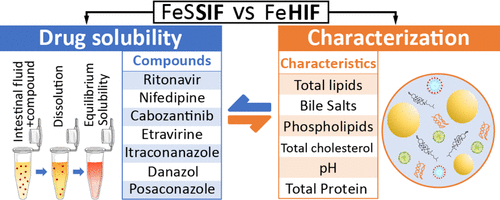Understanding the impact of lipids on the solubilizing capacity of human intestinal fluids

Lipids in human intestinal fluids (HIF) form various structures, resulting in phase separation in the form of a lipid fraction and a micellar aqueous fraction. Currently used fed state simulated intestinal fluids (SIF) lack phase separation, highlighting the need for a deeper understanding of the effect of these fractions on intestinal drug solubilization in HIF to improve simulation accuracy. In this study, duodenal fluids aspirated from 21 healthy volunteers in fasted, early fed, and late fed states were used to generate 7 HIF pools for each prandial state. The apparent solubility of seven lipophilic model drugs was measured across these HIF pools, differentiating between the micellar fraction and the total sample (including both micellar and lipid fractions). The solubilizing capacities of these fluids were analyzed in relation to their composition, including total lipids, bile salts, phospholipids, total cholesterol, pH, and total protein. The solubility data generated in this work demonstrated that current fed state SIF effectively predicted the average solubility in the micellar fraction of HIF but failed to discern the considerable variability between HIF pools. Furthermore, the inclusion of a lipid fraction significantly enhanced the solubility of fed state HIF pools, resulting on average in a 13.9-fold increase in solubilizing capacity across the seven model compounds. Although the average composition of the fluids was consistent with previous studies, substantial variability was observed in micellar lipid concentrations, despite relatively stable total lipid concentrations. This variability is critical, as evidenced by the strong correlations between the solubilizing capacity of the micellar fraction and its micellar lipid concentrations. Additionally, this study identified that fluctuations in bile salt concentrations and pH contributed to the observed variability in micellar lipid concentration. In summary, the influence of the lipid fraction on solubility was 2-fold: it enhanced the solubility of lipophilic drugs in the total fluid, and contributed to the variability in the solubilizing capacity of the micellar fraction.

